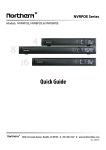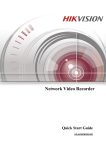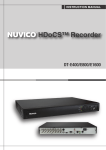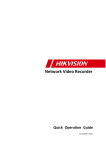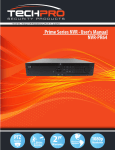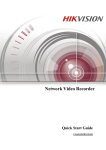Download Quick Guide - Tri
Transcript
NVR4POE / NVR8POE Quick Operation Guide 1 NVR4POE / NVR8POE Quick Operation Guide TABLE OF CONTENTS NVR Pre-Installation ....................................................................................................................................... 4 NVR Installation .............................................................................................................................................. 4 Front Panel ....................................................................................................................................................... 4 NVR4POE / NVR8POE Series .......................................................................................................... 4 Rear Panel ........................................................................................................................................................ 5 NVR4POE / NVR8POE ..................................................................................................................... 5 Peripheral Connections ................................................................................................................................... 5 Wiring of Alarm Output ............................................................................................................................. 5 Using of Alarm Connectors ........................................................................................................................ 6 Specifications .................................................................................................................................................... 7 Specifications of NVR4POE and NVR8POE ......................................................................................... 7 HDD Storage Calculation Chart ..................................................................................................................... 8 Setting up Admin Password ............................................................................................................................ 9 Login and Logout ............................................................................................................................................. 9 Accessing by Web Browser ............................................................................................................................ 10 Logging In................................................................................................................................................ 10 Live View ................................................................................................................................................. 12 Recording ................................................................................................................................................. 13 Playback ................................................................................................................................................... 14 Log……………………………………………………………………………………………………….15 Configuration ........................................................................................................................................... 16 Menu Operation ............................................................................................................................................. 18 Menu Structure......................................................................................................................................... 18 Startup and Shutdown .............................................................................................................................. 18 Live View ................................................................................................................................................. 19 Adding IP Cameras .................................................................................................................................. 19 Recording ................................................................................................................................................. 21 Instant Recording ............................................................................................................................. 21 All-day Recording ............................................................................................................................ 22 Playback ................................................................................................................................................... 22 Backup ..................................................................................................................................................... 23 2 NVR4POE / NVR8POE Quick Operation Guide Regulatory information FCC information FCC compliance: This equipment has been tested and found to comply with the limits for a digital device, pursuant to part 15 of the FCC Rules. These limits are designed to provide reasonable protection against harmful interference when the equipment is operated in a commercial environment. This equipment generates, uses, and can radiate radio frequency energy and, if not installed and used in accordance with the instruction manual, may cause harmful interference to radio communications. Operation of this equipment in a residential area is likely to cause harmful interference in which case the user will be required to correct the interference at his own expense. FCC conditions This device complies with part 15 of the FCC Rules. Operation is subject to the following two conditions: 1. This device may not cause harmful interference. 2. This device must accept any interference received, including interference that may cause undesired operation. EU Conformity Statement This product and - if applicable - the supplied accessories too are marked with "CE" and comply therefore with the applicable harmonized European standards listed under the Low Voltage Directive 2006/95/EC, the EMC Directive 2004/108/EC, the RoHS Directive 2011/65/EU. 2012/19/EU (WEEE directive): Products marked with this symbol cannot be disposed of as unsorted municipal waste in the European Union. For proper recycling, return this product to your local supplier upon the purchase of equivalent new equipment, or dispose of it at designated collection points. For more information see: www.recyclethis.info. 2006/66/EC (battery directive): This product contains a battery that cannot be disposed of as unsorted municipal waste in the European Union. See the product documentation for specific battery information. The battery is marked with this symbol, which may include lettering to indicate cadmium (Cd), lead (Pb), or mercury (Hg). For proper recycling, return the battery to your supplier or to a designated collection point. For more information see: www.recyclethis.info. Trademarks and Registered Trademarks • Windows and Windows mark are trademarks or registered trademarks of Microsoft Corporation in the United States and/or other countries. • HDMI, HDMI mark and High-Definition Multimedia Interface are trademarks or registered trademarks of HDMI Licensing LLC. • The products contained in this manual are authorized by HDMI Licensing LLC with the use right of the HDMI technology. 3 NVR4POE / NVR8POE Quick Operation Guide • VGA is the trademark of IBM. • UPnPTM is a certification mark of the UPnPTM Implementers Corporation. • Other names of companies and product contained in this manual may be trademarks or registered trademarks of their respective owners. NVR Pre-Installation The NVR is highly advanced surveillance equipment that should be installed with care. Please take into consideration the following precautionary steps before installation of the NVR. 1. Keep all liquids away from the NVR. 2. Install the NVR in a well-ventilated and dust-free area. 3. Ensure environmental conditions meet factory specifications. 4. Install a manufacturer recommended HDD. NVR Installation During the installation of the NVR: 1. 2. 3. 4. 5. 6. 7. 8. Use brackets for rack mounting (NVR8POE Only). Ensure there is ample room for audio and video cables. When routing cables, ensure that the bend radius of the cables are no less than five times than its diameter. Connect both the alarm and RS-485 cable. Allow at least 2cm (≈0.75-inch) of space between racks mounted devices. Ensure the NVR is grounded. Environmental temperature should be within the range of -10 ºC ~ 55 ºC, 14ºF ~ 131ºF. Environmental humidity should be within the range of 10% ~ 90%. Front Panel NVR4POE / NVR8POE Series No. Name Description Power 1 Status Indicator Status Tx/Rx Power indicator turns green when system is running. Status indicator blinks red when data is being read from or written to HDD. Tx/Rx indictor blinks yellow when network connection is functioning properly. Universal Serial Bus (USB) ports for additional devices such as 2 USB Interface USB mouse and USB Hard Disk Drive (HDD). 4 NVR4POE / NVR8POE Quick Operation Guide Rear Panel NVR4POE / NVR8POE NVR4POE NVR8POE No. Item 1 Power Supply Description 48V DC power supply for NVR4POE and AC 100~240V for NVR8POE. 2 Audio In RCA connector for audio input. 3 HDMI Interface HDMI video output connector. 4 LAN Network Interface 1 10 /100 /1000 Mbps self-adaptive Ethernet interface 5 Audio Out RCA connector for audio output. 6 VGA Interface DB9 connector for VGA output. Display local video output and menu. 7 USB Interface Universal Serial Bus (USB) ports for additional devices such as USB mouse and USB Hard Disk Drive (HDD). 8 Ground Ground (needs to be connected when NVR starts up). 9 Power Switch Switch for turning on/off the device. 10 Network Interfaces with PoE function Network interfaces for the cameras and to provide power over Ethernet. Peripheral Connections Wiring of Alarm Output To connect to an alarm output (AC or DC load), use the following diagram: DC Load Connection Diagram AC Load Connection Diagram 5 NVR4POE / NVR8POE Quick Operation Guide For DC load, the jumpers can be used within the limit of 12V/1A safely. To connect an AC load, jumpers should be left open (you must remove the jumper on the motherboard in the NVR). Use an external relay for safety (as shown in the figure above). There are 4 jumpers (JP1, JP2, JP3, and JP4) on the motherboard, each corresponding with one alarm output. By default, jumpers are connected. To connect an AC load, jumpers should be removed. Example: If you connect an AC load to the alarm output 3 of the NVR, then you must remove the JP 3. Using of Alarm Connectors To connect alarm devices to the NVR: 1. Disconnect pluggable block from the ALARM IN /ALARM OUT terminal block. 2. Unfasten stop screws from the pluggable block, insert signal cables into slots and fasten stop screws. Ensure signal cables are in tight. 3. Connect pluggable block back into terminal block. 6 NVR4POE / NVR8POE Quick Operation Guide Specifications Specifications of NVR4POE and NVR8POE Model NVR4POE Video/Audio IP video input input Two-way audio input Incoming bandwidth Network NVR8POE 4-ch 8-ch 1-ch, RCA (2.0 Vp-p, 1kΩ) 40Mbps 80Mbps 80Mbps Outgoing bandwidth Remote connection Recording resolution 32 128 6MP/5MP/3MP/1080P/UXGA/720P/VGA/4CIF/DCIF/2CIF/CIF/QCIF Main stream: 50 fps (P) / 60 fps (N) Frame rate Video/Audio Sub-stream: 50 fps (P) / 60 fps (N) output HDMI/VGA output 1-ch, resolution: 1920 × 1080P /60Hz, 1600 × 1200 /60Hz, 1280 × 1024 /60Hz, 1280 × 720 /60Hz, 1024 × 768 /60Hz 1-ch, RCA (Linear, 1kΩ) Audio output Decoding Live view / Playback resolution Capability SATA 6MP/5MP/3MP/1080P/UXGA/720P/VGA/4CIF/DCIF/2CIF/CIF/QCIF 4-ch@1080P 8-ch@720P, 6-ch@1080P 1 SATA interface for 1 HDD 2 SATA interfaces for 2 HDDs Hard disk Up to 4TB for each disk Capacity Network interface External interface USB interface 1 × USB 2.0 and 1 × USB 3.0 Alarm in/out (Optional) 4/1 Interface PoE 1 RJ-45 10 /100 /1000 Mbps self-adaptive Ethernet interface Max. Power 4 independent 100 Mbps PoE network interfaces 8 independent 100 Mbps PoE network interfaces 50W 120W AF and AT Supported standard Power supply 48V DC 220V AC Consumption (without hard disk and PoE) ≤ 10W Working temperature Others -10 ºC ~ +55 ºC (+14 ºF~ + 131 ºF) 10 % ~ 90 % Working humidity Chassis Dimensions (W × D × H) 1U chassis 19-inch rack-mounted 1U chassis 315 × 230 × 45mm (12.4"×9.1"×1.8") 445 × 290 × 45mm (17.5" × 11.4" × 1.8") Weight (without hard disk) ≤ 1 kg (2.2 lb) 7 NVR4POE / NVR8POE Quick Operation Guide HDD Storage Calculation Chart The following chart shows an estimation of storage space used based on recording at one channel for an hour at a fixed bit rate. Bit Rate 96K 128K 160K 192K 224K 256K 320K 384K 448K 512K 640K 768K 896K 1024K 1280K 1536K 1792K 2048K Storage Used 42M 56M 70M 84M 98M 112M 140M 168M 196M 225M 281M 337M 393M 450M 562M 675M 787M 900M 4096K 1.8G 8192K 3.6G 16384K 7.2G Please note that supplied values for storage space used is just for reference. The storage values in the chart are estimated by formulas and may have some deviation from actual value. 8 NVR4POE / NVR8POE Quick Operation Guide Setting up Admin Password Purpose: For first-time access, you will need to activate the device by setting an admin password. No operation is allowed before this activation process. You can also activate the device via Web Browser, SADP or Client Software. Steps: 1. Input the same password in the text field of Create New Password and Confirm New Password. STRONG PASSWORD RECOMMENDED– We highly recommend you create a strong password of your own choosing (using a minimum of 8 characters, including upper case letters, lower case letters, numbers, and special characters) in order to increase the security of your product. And we recommend you reset your password regularly, especially in the high security system, resetting the password monthly or weekly can better protect your product. 2. Click OK to save the password and activate the device. For uninterrupted access to the NVR itt is very important you remember the password created during this activation process. For security purposes, in the event of a forgotten password, you will be required to email technical support with specific NVR information. password reset information. It may take up to one business day hours to receive the You can reach technical support at [email protected] Login and Logout Purpose: You must log into the device before operating the menu and other functions. Steps: 1. Select the User Name in the dropdown list. 2. Input Password. 3. Click OK to log in. 9 NVR4POE / NVR8POE Quick Operation Guide The device will be locked for 60 seconds if the admin user performs 7 failed password attempts (5 attempts for the guest/operator). User Logout Purpose: After logging out, the monitor returns to live view mode for any menu operations, you will need to enter user name and password to log in again. Steps: 1. Enter the Shutdown menu. Menu > Shutdown 2. Click Logout. Accessing by Web Browser You shall acknowledge that the use of the product with Internet access might be under network security risks. For avoidance of any network attacks and information leakage, please strengthen your own protection by creating a “strong” level password. Logging In You can get access to the device via a web browser. You may use one of the following listed web browsers: Internet Explorer 6.0, Internet Explorer 7.0, Internet Explorer 8.0, Internet Explorer 9.0, Internet Explorer 10.0, Internet Explorer 11.0, Apple Safari, Mozilla Firefox, and Google Chrome. The supported resolutions include 1024*768 and above. 10 NVR4POE / NVR8POE Quick Operation Guide Steps: 1. 2. Open web browser, input the IP address of the device and then press Enter. Login to the device. If the device has not been activated, you need to activate the device first before login. 1) Set the password for the admin user account 2) Click OK to login to the device. STRONG PASSWORD RECOMMENDED– We highly recommend you create a strong password of your own choosing (using a minimum of 8 characters, including upper case letters, lower case letters, numbers, and special characters) in order to increase the security of your product. And we recommend you reset your password regularly, especially in the high security system, resetting the password monthly or weekly can better protect your product. If the device is already activated, enter the user name and password in the login interface, and click the Login button. 3. Install the plug-in before viewing the live video and managing the camera. Please follow the installation prompts to install the plug-in. You may have to close the web browser to finish the installation of the plug-in. The unit is set to DHCP by default and will pull a DHCP address when connected to your network. This address can found by entering the NVR Menu > Configuration > Network > General Tab. If the unit does not pull a DHCP address, the default IP address is 192.0.0.64. The default user name is admin, and password is 12345. You may use one of the following listed web browsers: Internet Explorer 6.0, Internet Explorer 7.0, Internet 11 NVR4POE / NVR8POE Quick Operation Guide Explorer 8.0, Internet Explorer 9.0, Internet Explorer 10.0, Internet Explorer 11.0, Apple Safari, Mozilla Firefox, and Google Chrome. The supported resolutions include 1024*768 and above. When you log in for the first time, the system will remind you to install the Plug-in control. After the installation, you can configure and manage the device remotely. Live View The live view interface appears by default when you log in the device. The live view interface may differ according to different models. Interface Introduction No. Name Description Displays the list of channels and the playing and recording status of each channel. 1 Channel List The stream type can be switched by clicking the icon before the channel name: stands for main stream and for sub-stream. 2 Live View Window Displays the image of channel, and multi-window division is supported. 3 Play Control Bar Play control operations are supported. Pan, tilt, zoom operations are supported, as well as preset editing and 4 PTZ Control calling. PTZ function can only be realized if the connected camera supports PTZ control. 5 Video Parameters Configuration Brightness, contrast, saturation and hue of the image can be edited. Start Live View Steps: 1. In the live view window, select a playing window by clicking the mouse. 2. Double click a camera from the device list to start the live view. 12 NVR4POE / NVR8POE Quick Operation Guide 3. You can click the button on the toolbar to start the live view of all cameras on the device list. Refer to the following table for the description of buttons on the live view window: Icon Description Icon Select the window-division mode / Description / Start/Stop all live view / Capture pictures in the live view Start/Stop all recording / Previous/Next page Start/Stop two-way Audio Adjust volume mode / Open/Close audio / Enable/Disable digital zoom Full screen Recording Before you start Make sure the device is connected with HDD or network disk, and the HDD or network disk has been initialized for the first time to use. Two recording types can be configured: Manual and Scheduled. The following section introduces the configuration of scheduled recording. Steps: 1. Click Remote Configuration> Camera Settings> Record Schedule to enter Record Schedule settings interface. 2. Select the camera to configure the record schedule. 3. Check the checkbox of Enable Schedule to enable recording schedule. 4. Choose the day in a week to configure scheduled recording. 5. Click Edit to edit record schedule. 13 NVR4POE / NVR8POE Quick Operation Guide 1) Configure All Day or Customize Record: If you want to configure the all-day recording, please check the All Day checkbox. If you want to record in different time sections, check the Customize checkbox. Set the Start Time and End Time. Up to 8 segments can be configured and each segment cannot be overlapped. 2) Select a Record Type. The record type can be Continuous, Motion, Alarm, Motion & Alarm, Motion | Alarm and VCA. 3) Check the checkbox of Select All and click Copy to copy settings of this day to the whole week. You can also check any of the checkboxes before the date and click Copy. 4) Click OK to save the settings and exit the Edit Schedule interface. 6. Click Advanced to configure advanced record parameters. 7. Click Save to activate the above settings. Playback Interface Introduction No. Name Description 1 Channel List Displays the list of channels and the playing status of each channel. 14 NVR4POE / NVR8POE Quick Operation Guide 2 Playback Window Displays the image of channel. 3 Play Control Bar Play control operations are supported. 4 Time Line Displays the time bar and the records marked with different colors. 5 Playback Status Displays the playback status, including channel number and playback speed. 6 Calendar You can select the date to play. Start Playback Steps: 1. Click Playback on the menu bar to enter playback interface. 2. Click the camera from the device list for playback. 3. Select the date from the calendar and click Search. 4. Click the Play button to play the video file searched on the current date. 5. Use the buttons on the toolbar to operate in playback mode. Button / / Description Button Description Play/Pause Stop Slow down Speed up Play by single frame Capture Stop all playback Download Video clip / Full screen Open/Close audio Reverse playback 6. You can drag the progress bar with the mouse to locate the exact playback point. You can also input the time in the textbox and click button to locate the playback point. The color of the video on the progress bar stands for the different video types. Log You can view and export the log files at any time, including operation, alarm, exception and information of device. Before you start: The Log function can be realized only when the device has a Hard Drive installed. Steps: 1. Click Log on the menu bar to enter the Log interface. 15 NVR4POE / NVR8POE Quick Operation Guide 2. Set the log search conditions to refine your search, including the Major Type, Minor Type, Start Time and End Time. 3. Click the Search button to start searching log files. 4. The matched log files will be displayed on the list. Up to 2000 log files can be found each time, and 100 log files can be displayed on each page. You can click the button to save the searched log files to local directory. Configuration The configuration tab is used to access many of the same features available when working directly from the NVR as well as some features which are only available through the Web Browser. This section focuses on those features that can only be accessible through the Web Browser. Local Configuration (PC/Browser settings) Protocol – Choose between TCP and UDP (TCP is recommended). Stream Type – Select between Main Stream or Sub Stream for remote viewing. Image Size – Select to display cameras in 4:3 or 16:9 aspect ratios. Record File Size – Select either 512M or 1G record file sizes. Live View Performance – Choose either Shortest Delay, Real Time, Balanced or Fluency for viewing quality settings. Auto Start Live View – Check this box if you want your live view cameras to populate in the live view window automatically. If left unchecked cameras will have to be added manually to the live view window. Rules – Enable or Disable Rules (this section requires rules be set up on individual cameras first – for setting up rules please refer to the Northern IP camera Manual). The following section is for setting up the file paths where you would like Record Files, Snapshots in 16 NVR4POE / NVR8POE Quick Operation Guide Live/Playback, Clips and Downloaded files to record to. Each option provides a browse button which can be clicked on to select a file path directory. Save Record Files to: Save Snapshots in Live View to: Save Snapshots in Playback to: Save Clips to: Save Downloaded Files to: IP Camera Management The IP Camera Management option allows you to log into those cameras connected directly to the POE ports on the back of the NVR. This can be used to access advanced camera features not accessible through the NVR. In order to access cameras you must first check the virtual host box under Network Settings. (Remote Configuration → Network → Advanced) Once this box is checked you can enter the Camera Management section as shown below. (Remote Configuration → Camera Management → IP Camera) 17 NVR4POE / NVR8POE Quick Operation Guide To log directly into a camera click on the cameras IP address under the Connect tab. You will then be prompted to enter the cameras username and password. Once you have entered the camera login information you will enter the cameras set up software and have access to advanced camera features. For all settings not covered in this section please refere to the users manual for detailed information. Menu Operation Menu Structure The menu structure of DS-8600NI-E8 and DS-7700NI-E4 series NVR. The menu structure may vary according to different models. Startup and Shutdown Proper startup and shutdown procedures are crucial to expanding the life of the NVR. To start your NVR: Steps: 1. Check the power supply is plugged into an electrical outlet with correct voltage. It is HIGHLY recommended that an Uninterruptible Power Supply (UPS) be used in conjunction with the device. 2. After connecting the power supply (NVR4POE) or power cord (NVR8POE) to the NVR, flip the power switch to the “ON” position represented by a (•) on the NVR4POE and a () on the NVR8POE 3. The Power LED should turn green and the unit will begin to start. After the device starting up, the wizard will guide you through the initial settings, including modifying password, date and time settings, network settings, HDD initializing, and recording. It is HIGHLY recommended to change default passwords. 18 NVR4POE / NVR8POE Quick Operation Guide To shut down the NVR: Steps: 1. Enter the Shutdown menu. Menu > Shutdown 2. Select the Shutdown button. 3. Click the Yes button. 4. Turn off the power switch on the rear panel when the attention pops up. 5. When the unit is powered down both the Power and Tx/Rx lights on front panel will be solid green. Live View Some icons are provided on screen in Live View mode to indicate different camera status. These icons include: Live View Icons In the live view mode, there are icons at the upper-right corner of the screen for each channel, showing the status of the record and alarm in the channel, so that you can find problems as soon as possible. Alarm (video loss, tampering, motion detection or sensor alarm) Record (manual record, continuous record, motion detection or alarm triggered record) Alarm & Record Event/Exception (event and exception information, appears at the lower-left corner of the screen.) Adding IP Cameras You should add and configure the online IP cameras to enable the live view and recording function. PnP PoE camera models IP3B, IP3T, IP3W, IP3VFB, IP3VFD will automatically display when connected to the PoE ports on the back of the NVR. The following information is for adding cameras on the network, not connected directly to the NVR. Steps: 19 NVR4POE / NVR8POE Quick Operation Guide 1. Right-click the mouse when in the live view mode to show the right-click menu. 2. Select Add IP Camera in the pop-up menu to enter the IP Camera Management interface. 3. The online cameras with same network segment will be displayed in the camera list. Click the add the camera. button to The added camera is marked in white while the camera has not been added is marked in yellow. Explanation of the icons Icon Explanation Icon Edit basic parameters of the camera Explanation Add the detected IP camera. The camera is disconnected; you can The camera is connected. click the icon to get the exception information of camera. Delete the IP camera 4. Advanced settings of the camera. To add other IP cameras: 1) Click the Custom Adding button to pop up the Add IP Camera (Custom) interface. 20 NVR4POE / NVR8POE Quick Operation Guide 2) You can edit the IP address, protocol, management port, and other information of the IP camera to be added. 3) Click Add to add the camera. 4) (For the encoders with multiple channels only) check the checkbox of Channel No. in the pop-up window, as shown in the following figure, and click OK to finish adding. Recording Purpose: Two kinds of record types are introduced in the following section, including Instant Record and All-day Record. And for other record types, you may refer to the user manual for detailed information. After rebooting all the manual records enabled are canceled. Instant Recording On the live view window of each channel, there is a quick setting toolbar which shows on the bottom of the window when you click on it. Click the icon to enable the record, and the icon turns to then the icon turns to . 21 . And click icon to disable the record, NVR4POE / NVR8POE Quick Operation Guide All-day Recording Steps: 1. On the live view window, right lick the window and move the cursor to the Start Recording option, and select Continuous Record or Motion Detection Record on your demand. 2. And click the Yes button in the popup Attention message box to confirm the settings. Then all the channels will start to record in the selected mode. Playback Play back the record files of a specific channel in the live view menu. Channel switch is supported. Option 1: Choose a channel under live view using the mouse and click the button in the shortcut operation menu. Only record files recorded during the past five minutes on this channel will be played back. Option 2: Steps: 1. Enter the Playback menu. Mouse: right click a channel in live view mode and select Playback from the menu. 22 NVR4POE / NVR8POE Quick Operation Guide Under multi-screen live view, record files of the selected channel will be played back. Pressing numerical buttons will switch playback to related channels during playback process. 2. Playback management. The toolbar in the bottom part of Playback interface can be used to control playing process. Just check the channel or channels if you want to switch playback to another channel or execute simultaneous playback of multiple channels. Backup Recorded files can be backed up to various devices, such as USB flash drives, USB HDDs or a DVD writer. Steps: 1. Enter Video Export interface. Choose the channel(s) you want to back up and click on the Quick Export button. 2. Enter Export interface, choose backup device and click Export button to start exporting. 23 NVR4POE / NVR8POE Quick Operation Guide 3. Check backup result. Choose the recording file in Export interface and click button 24 to check it.

























